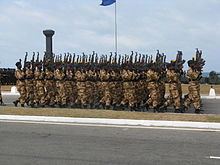Role Civil Defence Founded 1986 Engagement Sri Lankan Civil War | Type Militia Size 39,800 | |
 | ||
Active January 1, 1986 - Present Engagements Sri Lankan Civil War, Sri Lankan Humanitarian Operation Against LTTE Motto Protect the Nation with Self-Sacrifice Similar Special Task Force, Sri Lanka Armed Forces, Sri Lanka Army, Sri Lanka Navy, Sri Lanka Air Force | ||
The Sri Lanka Civil Security Force (Tamil: இலங்கை சிவில் பாதுகாப்பு) (also known as the Civil Defence Force, originally the National Home Guard Service) is a paramilitary force which is tasked as an auxiliary to the Sri Lanka Police. It is directed by the Civil Security Department.
Contents
The activities relating to the Home Guard Service were established under the Mobilization of Supplementary Force Act No. 40 of 1985. The local home guards came under the command of the local police. They are all volunteers deployed in their home towns and villages, to protect the civilian population from attacks by the LTTE. With the establishment of Civil Security Department, the Home Guards were re-designated as the Civil Security Force and came under the purview of the Ministry of Defence. The force is distinct from the Sri Lanka National Guard, which is a volunteer reserve regiment of the Sri Lanka Army.
The current Director General of the Civil Security Department is Mr Chandrarathne Pallegama (BSc, PGD, MAAT, MA).
Functions
The functions to be performed by Home Guards are listed below:
Special duties
History and establishment
Following the start of Sri Lankan civil war many villages were attacked by LTTE which resulted in the deaths of many civilians. Due to these attacks the villagers began to organize themselves to protect themselves. The original Home Guards were local volunteers, who were initially armed with shotguns by the government to protect themselves. National Home Guard Service was established as a Voluntary Service in the mid 1980s to protect the border/ threatened villages. They were issued with 12 bore shot guns and brown coloured uniforms. No allowances were paid, but some rations were issued through co-operative outlets. Subsequently, they were paid a daily allowance and placed under the Police Department. Training was carried out at Kumbuka camp, Horana
In 1986 the Home Guard Service was created by the then Minister of National Security the late Hon. Lalith Athulathmudali with a strength of about 5000 personnel. They were issued uniforms and weapons (mostly shotguns) and were under the command of the local Sri Lankan Police units. In 1988 female guardswomen were joined to the force. Since 1993 they have been issued with automatic rifles. In April 2006 the Home Guard was renamed as the Civil Defence Force followed by the establishment of the Department of Civil Security on 1 January 2007. Since its consumption its members have been deployed outside their home villages to maintain public security even in Colombo.
His Excellency the President Mr. Mahinda Rajapakse by gazette notification No. 1462/20 dated 13 September 2006, re-structured the whole Home Guard Service and established the Civil Security Department. Numbers employed increased to 41,500 and one-month military training was introduced. Further, two types of uniforms similar to military uniforms were issued. A reasonable salary was paid for the employees.
Functions of the Civil Security Department as per Gazette notification No 1462/20 dated 13 September 2006 are as follows:
At present the CSD personnel continue to uplift the livelihood of the communities of respective villages through undertaking many projects in spheres of agriculture, archaeology, culture, spiritual, social welfare development, animal husbandry, sport development, construction and brick production projects.
The Director Generals who have served before are Rear Admiral Sarath Weerasekare (MA, MPhil) and Rear Admiral Ananda Peiris (RSP, VSV, USP, NDC, PSC, DISS). Approximately 75 officers from the Armed Services and Police were attached for better administration. The current third Director General of the Civil Security Department is Mr Chandrarathne Pallegama (BSc, PGD, MAAT, MA), an administrator from the Sri Lanka Administrative Service (SLAS).
Strength
Over 39,800 serve in all districts and provinces, but are mostly deployed in villages affected by attacks from the LTTE, in the Northern and the Eastern provinces. They are also deployed in major cities and towns to assist the police in maintaining public security.
Ranks
Training
Training is provided in two stages. Basic training is provided by the Sri Lankan Army at various army training centres, usually for 2–4 weeks. Additional training is carried out from time to time by mobile training units in the areas where units are deployed.
Equipment
The Civil Security Force is trained to use and are equipped with weapons such as the Type 56 assault rifles, L1A1 Self-Loading Rifles, .303 Lee–Enfield rifles and shotguns.
